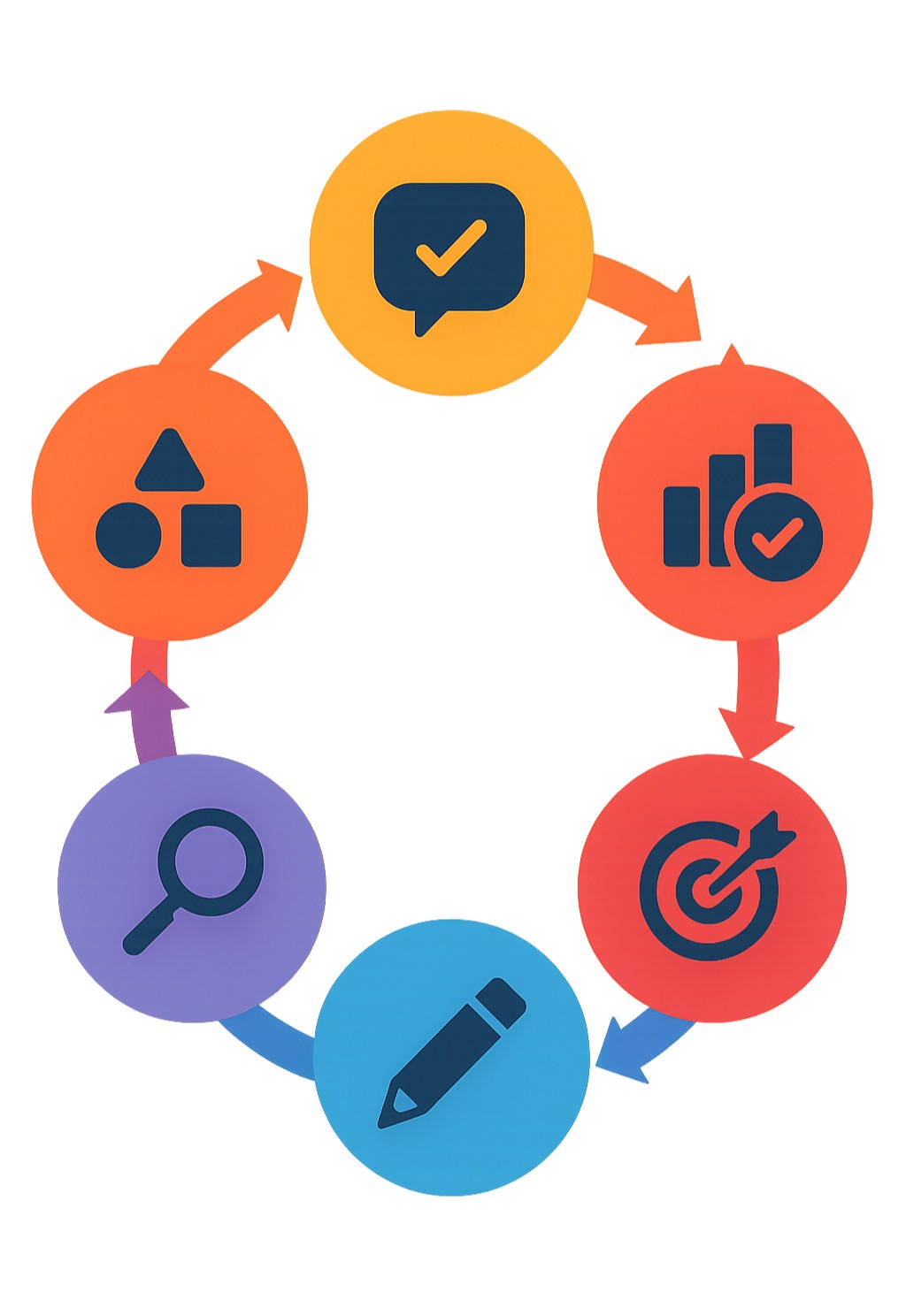Don't Just Prompt, Evaluate! Essential Tools for AI Success
Why Prompt Evaluation is the Missing Piece in Your AI Strategy.

Prompt evaluation is the systematic process of assessing how well your AI prompts achieve their intended goals. It's what separates professionals who consistently get great results from those stuck in endless trial-and-error cycles.
Quick Answer: How to Evaluate Prompts Effectively
- Define clear success metrics - relevance, accuracy, consistency, efficiency
- Choose your evaluation method - human review, automated metrics, or LLM-as-a-judge
- Test with diverse inputs - including edge cases and stress tests
- Track performance over time - monitor degradation and improvements
- Iterate based on results - refine prompts using evaluation feedback
Here's the reality: most AI users rely on "vibe checks" to judge their prompts. They tweak something, see if it feels better, and hope for the best. This approach wastes time, burns through API costs, and delivers inconsistent results.
The data tells a different story. Teams using structured prompt evaluation cut their testing cycles by up to 75%. They see measurable improvements in semantic alignment, with BERTScore improvements from 0.85 to 0.92. Most importantly, they can provide concrete performance metrics when stakeholders ask tough questions.
As one industry expert put it: "What makes one prompt more effective than another? And how can we quantify and document those differences? That's where prompt evaluations come in."
The shift from gut feeling to data-driven prompt engineering isn't just about better results. It's about building AI systems that scale, maintain quality over time, and earn user trust. When Netflix lists prompt engineering positions at $900,000 per year, they're not paying for guesswork—they're investing in systematic excellence.

Why Prompt Evaluation is Non-Negotiable for AI Success
Picture this: you've built an amazing AI application, but every time someone uses it, they get wildly different results. One day it's brilliant, the next it's... well, let's just say your users aren't happy. Sound familiar?
This is exactly why prompt evaluation isn't just a nice-to-have—it's absolutely essential for any serious AI project. Without it, you're essentially flying blind, hoping your prompts work instead of knowing they do.
Think about what happens when your prompts aren't properly evaluated. Your AI starts giving inconsistent answers, users get frustrated, and you're burning through API credits faster than you can say "hallucination." Meanwhile, your team is stuck in endless cycles of tweaking and testing, never quite sure if they're making things better or worse.
Prompt evaluation solves these problems by giving you a systematic way to measure and improve your AI's performance. It's like having a quality control system for your prompts—ensuring they deliver consistent outputs every single time.
Here's why it matters so much for your AI success:
Quality assurance becomes automatic when you evaluate your prompts properly. Instead of crossing your fingers and hoping for good results, you can guarantee that your AI delivers reliable, high-quality responses. Your users will notice the difference immediately.
Performance optimization is another huge win. Better prompts mean your AI runs faster with lower latency and higher throughput. Your applications become more responsive, handling more requests without breaking a sweat.
The cost efficiency benefits are eye-opening. When your prompts are optimized, you need fewer API calls to get the results you want. This translates directly to reduced inference costs—sometimes dramatically so.
Most importantly, user experience improves across the board. When your prompts are evaluated and refined, users get more accurate, helpful responses. They trust your AI more, use it more often, and recommend it to others.
The Quantifiable Impact of Systematic Evaluation
The numbers don't lie—teams that adopt systematic prompt evaluation see real, measurable improvements. They report a 75% reduction in testing cycles, freeing up valuable time for development. The quality improvements are equally impressive, with teams seeing improved semantic alignment and BERTScore improvements jumping from 0.85 to 0.92. This represents a significant leap in the AI's ability to understand user intent.
When you make data-driven decisions, you're no longer guessing which version works better; you have concrete metrics to guide your choices. This is invaluable for presenting investor metrics or reporting to stakeholders. Systematic evaluation leads to better workflow optimization and is crucial for reducing AI hallucinations, ensuring your AI provides accurate, trustworthy responses.
A Framework for Systematic Prompt Evaluation
Let's be honest—most of us have been winging it with our prompts. We write something, see if it works, maybe tweak it a bit, and call it a day. But prompt evaluation deserves better than guesswork.
Building a solid framework starts with getting crystal clear on your evaluation goals. What exactly are you trying to achieve? Are you after razor-sharp accuracy for a medical chatbot? Creative flair for marketing copy? Lightning-fast responses for customer service? Your goals will shape everything that follows.
Once you know what you're aiming for, you need benchmark datasets. Think of these as your "gold standard"—carefully curated sets of inputs and expected outputs that give you something concrete to measure against. Without benchmarks, you're basically shooting arrows in the dark and hoping you hit something good.
The evaluation landscape splits into two main camps: subjective versus objective methods. Subjective evaluation relies on human judgment—great for nuanced tasks but slow and expensive. Objective evaluation uses automated metrics—fast and scalable but sometimes misses the subtleties that matter most.
You'll also need to choose between automated and human evaluation approaches. Automated methods can process thousands of prompts in minutes, while human evaluation catches the nuanced details that algorithms miss. The sweet spot? Most successful teams use both.
Scalability becomes crucial as your AI applications grow. What works for testing 10 prompts might crumble under 10,000. And let's not forget contextual understanding—your evaluation framework needs to grasp whether the AI truly gets what you're asking for, not just whether it produces grammatically correct sentences.

Key Metrics: Defining What "Good" Looks Like
Here's where things get practical. You can't improve what you don't measure, so let's define what "good" actually means for your prompts.
Relevance sits at the heart of every great prompt. Does your AI actually answer the question you asked? It sounds obvious, but you'd be surprised how often responses wander off into tangent land. A relevant response stays laser-focused on your specific request.
Accuracy becomes non-negotiable when facts matter. Your AI might sound confident, but confidence without correctness is just expensive fiction. This metric checks whether the information provided is actually true and verifiable.
Consistency separates professional AI applications from amateur hour. When you ask similar questions, you should get similar quality responses. Users notice when your AI is brilliant one moment and bewildering the next.
Efficiency measures whether your prompt gets the job done without wasting time or tokens. Why use 500 words when 50 will do? Efficient prompts save money and keep users happy.
Readability and coherence ensure your AI's responses actually make sense to humans. The output should flow naturally, with ideas connecting logically from one sentence to the next. Fluency takes this further—does the text sound natural, or does it read like a robot wrote it?
User satisfaction cuts through all the technical metrics to ask the only question that really matters: do people actually find this helpful? You can measure this through ratings, surveys, or usage patterns.
Factual correctness digs deeper than basic accuracy, cross-referencing specific claims against reliable sources. Conciseness rewards brevity—getting to the point without unnecessary fluff.
Finally, safety ensures your AI won't embarrass you (or worse). This covers everything from avoiding harmful content to steering clear of biased or inappropriate responses. This isn't optional—it's essential.
Choosing Your Method: A Comparative Guide to Prompt Evaluation
Now comes the million-dollar question: how do you actually evaluate your prompts? You've got several powerful options, each with its own personality.
| Evaluation Method | Description | Pros | Cons |
|---|---|---|---|
| Human Evaluation | Human experts assess AI outputs based on predefined criteria (e.g., accuracy, relevance, fluency). | Provides qualitative insights, captures nuance, gold standard for subjective tasks. | Subjective, time-consuming, expensive, not scalable, low inter-rater agreement can be a challenge. |
| Automated Metrics | Uses algorithms to compare AI outputs against reference answers (e.g., BLEU, ROUGE, BERTScore, Cosine Similarity). | Fast, scalable, objective, cost-effective for large datasets. | Surface-level assessment, may not capture semantic meaning or factual accuracy, sensitive to wording changes. |
| LLM-as-a-Judge | An LLM evaluates the quality of outputs generated by another LLM or the same model. | Scalable, cost-effective (compared to humans), can provide contextual feedback, automates qualitative assessment. | Can exhibit bias (e.g., preference for its own outputs), may struggle with complex reasoning, requires careful prompt engineering for the "judge" LLM. |
| A/B Testing | Compares two or more prompt variations by exposing them to different user groups or datasets. | Provides direct comparison of performance in real-world scenarios, identifies optimal prompt variations, quantifies impact of changes. | Requires sufficient traffic/data, can be slow, might not explain why one prompt performs better, complex to set up for multiple variations. |
Human evaluation remains the gold standard, especially for subjective tasks. Real people catch nuances that algorithms miss—the difference between technically correct and actually helpful. But here's the catch: it's expensive, slow, and humans don't always agree. One study found human judges rating summary quality with a Krippendorff's alpha of just 0.07. That's basically random agreement!
Automated metrics offer speed and consistency. BLEU scores measure n-gram overlap—useful for translation tasks. ROUGE focuses on recall, making it perfect for summarization. BERTScore uses contextual embeddings to understand semantic similarity, while cosine similarity with sentence embeddings measures how close your output is to the ideal response. These methods process thousands of examples in minutes, but they can miss subtle meaning differences.
LLM-as-a-Judge represents an exciting middle ground. You use a powerful model like GPT-4 to evaluate other AI outputs. It's like having a really smart assistant who can work 24/7 without coffee breaks. The G-EVAL framework shows how to make these AI judges more reliable by having them explain their reasoning first. Just watch out for bias—LLMs sometimes prefer their own outputs.
A/B testing gives you real-world answers. Create multiple prompt versions, test them with actual users or data, and see which performs better. It's the ultimate reality check, though it requires patience and sufficient traffic to get meaningful results.
The smartest approach? Don't pick just one. Combine methods based on your needs, budget, and timeline. Start with automated metrics for quick feedback, use human evaluation for nuanced tasks, and validate everything with A/B testing when possible.
The Modern Prompt Engineer's Toolkit
Picture this: you're crafting the perfect prompt, but you're doing it in a vacuum. No version history, no collaboration, no way to track what worked and what didn't. Sound familiar? This is exactly why modern prompt evaluation demands more than just good methodology—it needs the right tools to back it up.
The days of copying and pasting prompts between random documents are over. Today's prompt engineers work with prompt playgrounds that let them test ideas quickly, version control systems that track every change, and evaluation libraries that provide scientific rigor to their work. These aren't just nice-to-haves; they're essential for moving beyond individual "vibe checks" to a systematic, team-oriented approach.
Think of it like this: a carpenter wouldn't try to build a house with just a hammer. Similarly, we need a complete toolkit that includes visual prompt management, usage statistics, and analytics that actually inform our optimization efforts. The goal is to create centralized repositories where teams can collaborate seamlessly, building on each other's work rather than starting from scratch every time.

Essential Tools for Testing and Versioning
Here's where things get exciting. The best prompt engineers are borrowing principles from software development, especially test-driven development. This means defining your test cases and expected outcomes before you even write the final prompt. It sounds backwards, but it works brilliantly.
Tools like promptfoo make this approach incredibly practical. You can define simple, declarative test cases, run evaluations, and analyze results in a structured format. What's really cool is that these tools even offer features like red teaming, which helps identify vulnerabilities and risks in your LLM applications before they become problems. The fact that these are open-source tools means they run privately and offer complete transparency—no black boxes.
For broader evaluation needs, Hugging Face's evaluate library provides ready-to-use metrics and datasets for common NLP tasks. It's like having a scientific lab for your prompts, complete with standardized tests and benchmarks.
But here's the game-changer: treating your prompts like code. This means embracing robust version control systems that track every change, just like software developers use Git. Semantic versioning (following the X.Y.Z format) is particularly effective for prompt updates—major changes get the X bump, new features get Y, and bug fixes get Z. The Semantic Versioning guidelines provide a solid framework for this approach.
This systematic approach to versioning enables meticulous change tracking. You'll know exactly what changed, when, and why. More importantly, it facilitates true collaboration, allowing teams to work on prompts concurrently without stepping on each other's toes. Features like caching and concurrency make the evaluation process faster and more efficient, while a centralized prompt repository becomes your single source of truth.
The beauty of modern collaboration platforms is that they transform prompt engineering from a solo activity into a team sport. When everyone can see what's been tried, what worked, and what didn't, the whole team gets smarter faster.
From Feedback to Refinement: Integrating Evaluation into Your Workflow
Think of prompt evaluation as your AI's personal trainer—it's not a one-time workout, but an ongoing fitness regimen. The magic happens when you weave evaluation into your daily development routine, creating a continuous cycle of improvement.
The most successful teams treat prompt evaluation like they treat code reviews. They build it right into their Continuous Integration/Continuous Deployment (CI/CD) pipelines. Every time someone updates a prompt, automated tests kick in to make sure the new version doesn't break anything or perform worse than before.
But here's where it gets really interesting: monitoring doesn't stop once your prompts go live. You need to keep watching how they perform in the real world. Users have a way of finding edge cases you never thought of, and model behavior can shift over time. This feedback analysis becomes the fuel for your next round of improvements.

Best Practices for Optimizing Prompts
Your evaluation results are like a GPS for prompt improvement—they tell you exactly where to go next. Here's how to turn that feedback into better prompts.
Be ruthlessly specific with your instructions. Vague prompts are like giving someone directions by saying "go that way." The AI needs clear, concrete guidance about what you want. Provide rich context so the model understands the full picture, not just the immediate task.
Use delimiters like triple quotes or XML tags to separate different parts of your prompt. This helps the AI understand what's instruction versus what's content to work with. Few-shot examples are your secret weapon—show the AI a couple of perfect examples, and it'll often nail the pattern you're looking for.
Chain-of-thought prompting works wonders for complex tasks. Simply asking the AI to "think step-by-step" or "work through this problem" often leads to more accurate and logical outputs. It's like asking someone to show their work in math class.
Don't be afraid to refine your wording based on what evaluation tells you. Sometimes changing "summarize" to "create a brief overview" makes all the difference. Adjust parameters like temperature and token limits to fine-tune the output style and length.
Most importantly, test edge cases ruthlessly. Your prompts might work perfectly for typical inputs but fall apart when users throw curveballs. Push your prompts to their limits during testing—it's better to find problems in development than in production.
Using Evaluation to Minimize AI Hallucinations
AI hallucinations are like that friend who confidently gives you wrong directions—they sound convincing but lead you astray. Prompt evaluation is your best defense against these confident mistakes.
Source citation is a game-changer. When you instruct the AI to quote its sources or provide references, it becomes accountable for its claims. This makes fact-checking much easier and often reduces hallucinations simply because the AI has to "show its work."
Fact-checking prompts can be built right into your evaluation process. Design specific tests that ask the AI to verify information or identify inconsistencies. Some teams even create "fact check lists" as part of their prompt patterns.
Confidence scoring helps you spot potential problems before they reach users. When the AI seems uncertain about its response, that's a red flag worth investigating. Through rigorous testing, especially with tricky edge cases, you'll start to identify failure modes—specific types of inputs that consistently cause problems.
For systems that work with documents or databases, grounding responses in provided context is crucial. Your evaluation should verify that the AI sticks to the information you've given it instead of making things up. This is especially important for Retrieval-Augmented Generation systems.
The goal isn't just to generate content—it's to generate reliable content that users can trust. When you systematically evaluate for factual accuracy and truthfulness, you're building that trust one prompt at a time.
Overcoming Common Challenges in Prompt Evaluation
Let's be honest—prompt evaluation isn't always smooth sailing. Even with the best intentions and solid frameworks, we run into real challenges that can make the process feel overwhelming. The good news? These problems are totally manageable once you know what you're dealing with.
Subjectivity is probably the biggest headache. Ask three different people to evaluate the same AI response, and you'll likely get three different scores. What one person considers "creative and engaging," another might find "verbose and off-topic." This inconsistency makes it tough to build reliable evaluation systems.
Then there's the issue of metric limitations. Automated metrics are fast and scalable, but they often miss the forest for the trees. A metric might give high marks to a response that perfectly matches keywords but completely misses the emotional tone or creative spark that makes content truly valuable.
Evaluation costs can sneak up on you too. Whether you're paying human reviewers or running thousands of LLM evaluations, the bills add up quickly. It's frustrating when you want to test thoroughly but have to balance that against budget constraints.
Context sensitivity creates another layer of complexity. A prompt that works beautifully in isolation might fall flat in a real conversation or specific application. The AI's performance can shift dramatically based on surrounding context, making evaluation results feel unreliable.
Bias in evaluation is trickier than it first appears. LLM-as-a-Judge systems often favor content generated by similar models, while human evaluators bring their own unconscious preferences to the table. This can skew results without you even realizing it.
Finally, scalability issues become a real problem as your AI applications grow. Manually reviewing every prompt iteration becomes impossible, but building robust automated systems requires significant technical investment.
Tackling Subjectivity and Semantic Nuance
The subjectivity challenge hits hardest when we're evaluating nuanced content like summaries, creative writing, or complex explanations. How do you objectively measure whether a summary captures the "essence" of a document?
This is where semantic evaluation becomes your best friend. Instead of relying on simple word matching, we can use sophisticated techniques that actually understand meaning.
BERTScore revolutionizes how we measure semantic similarity. It uses contextual embeddings from BERT to compare generated content with reference examples. Unlike traditional metrics that just count matching words, BERTScore understands that "happy" and "joyful" convey similar meanings, even if they're different words.
For even more precision, Sentence-BERT (SBERT) with cosine similarity gives us fixed-size sentence embeddings. We can generate embeddings for both the AI's output and our reference text, then calculate how closely they align semantically. Higher cosine similarity scores indicate better semantic alignment—it's like having a mathematical way to measure "closeness of meaning."
Word Mover's Distance takes a different approach by measuring the minimum "distance" words need to travel to transform one text into another. It considers semantic relationships between words, helping us understand how much meaning shifts between different versions of content.
The real magic happens when we combine methods strategically. Start with automated metrics for broad-scale filtering—they'll quickly identify obvious winners and losers. Then bring in human-in-the-loop evaluation for the nuanced stuff that really matters. Human reviewers excel at catching tone, creativity, and overall helpfulness that metrics simply can't measure.
Create detailed rubrics that break down subjective criteria into measurable components. Instead of asking "Is this creative?" ask "Does this use unexpected analogies?" or "Does this approach the topic from a fresh angle?" This makes human evaluation more consistent and reliable.
Prompt evaluation is itself an iterative process. As you gather feedback from all sources—automated metrics, human reviewers, and real-world performance—use that information to refine not just your prompts, but your evaluation methods too.
The goal isn't to eliminate subjectivity entirely (that's impossible), but to manage it thoughtfully so you can build AI applications that truly deliver value to your users.
Conclusion
The journey from a simple prompt to a reliable, high-performing AI application is paved with systematic prompt evaluation. It's the critical bridge that transforms prompt engineering from an intuitive art into a data-driven science.
Think about where we started—most teams relying on "vibe checks" and endless trial-and-error cycles. Now you have a complete framework for prompt evaluation that includes defining clear goals, employing diverse evaluation methods, leveraging powerful tools, and integrating feedback into a continuous workflow.
This systematic approach leads to continuous improvement, ensuring the reliability and building the user trust that is essential for the future of AI development. We've seen how better prompts lead to more efficient AI resource usage, reduced costs, and significant improvements in semantic alignment and overall performance.
The data speaks for itself: teams using structured evaluation cut their testing cycles by up to 75%. They see measurable improvements in semantic alignment, with BERTScore jumping from 0.85 to 0.92. Most importantly, they can confidently show stakeholders concrete performance metrics instead of crossing their fingers and hoping for the best.
Prompt evaluation isn't just about individual success—it's about changing how we approach AI development as a whole. When we move from gut feelings to data-driven decisions, we create AI systems that scale, maintain quality over time, and earn user trust.
At Potions, we believe that prompt evaluation is not just an individual skill, but a collaborative craft. Our platform is built on a robust version control system, where every prompt is automatically saved, versioned, and given a stable URL. This makes it easy to track changes, experiment freely, and build upon each other's work.
We're changing how prompt engineering is done, allowing users to instantly search hundreds of proven prompts, remix them for their needs, and contribute back to a growing library of AI expertise. It's the future of AI development—where collaborative prompt engineering becomes the norm, not the exception.
Don't let your AI success be a matter of chance. Accept systematic prompt evaluation and join us in shaping a future where AI applications are consistently excellent, reliable, and truly trustworthy.